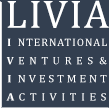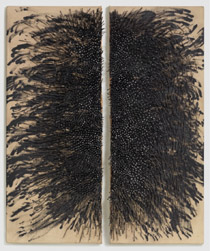Nails and blackboard varnish on canvas on panel each approx. 200 x 80 x 17 cm, total dimensions: approx. 200 x 170 x 17 cm. The reverse of panel signed, dated and titled ‘GESPALTEN Uecker ’87 Uecker ’87’ with directional arrow and information plus installation instructions and dimensions.
The masterpiece “Gespalten” is one of Günther Uecker’s most important works and gives us profound insights into the artist’s creative methods. From an early stage his entire oeuvre has been marked by an amazing clarity of composition and very precise statements. Uecker’s use of the nail as his central tool and medium goes back to the late 1950s and has continued to the present day. Also, from the very beginning, other basic recurring elements of his art have been light and movement.
Günther Uecker was born on March 13, 1930, in Wendorf, Mecklenburg, Germany. He is a sculptor, set designer, and Kinetic artist. He studied art at Wismar and at the Berlin-Weissensse Academy from 1949 to 1953. His first work was social-realist in style. Until 1957 he attended the Düsseldorf Academy and during those years he started painting using relief elements. In 1957 he simplified his palette to black, red, or white, and his work comprised patterns of dots or horizontal and vertical lines scattered across the surface of the painting.
The year 1957 also marked the production of the artist’s first nail relief. This was the first stage of his experimentation with relief, which would later lead him to apply other objects on the surface of the painting, such as corks or cardboard tubes.
Uecker taught from 1974 until 1995 at the Kunstakademie Düsseldorf and was promoted to professor in 1976.
The artist’s work can be found in the collections of major institutions worldwide, among them: the ZERO foundation and Museum Kunst Palast, Düsseldorf; Calderara Foundation Collection, Milan; Courtauld Institute of Art, (London); Honolulu Museum of Art, the Schleswig-Holstein Museums (Germany), Studio Esseci (Padua, Italy), Stedelijk Museum, Amsterdam, Van Abbemuseum (Eindhoven, Netherlands), Von der Heydt-Museum (Wuppertal, Germany); Museum of Modern Art, New York; Art Institute of Chicago, Chicago; Museum of Contemporary Art, Los Angeles; Centre Pompidou, Paris; Peggy Guggenheim Collection, Venice; and the Walker Art Center, Minnesota



